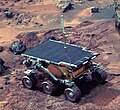
The Lunar Roving Vehicle (LRV) is a battery-powered four-wheeled rover used on the Moon in the last three missions of the American Apollo program during 1971 and 1972. It is popularly called the Moon buggy, a play on the term dune buggy.

NASA's Mars Exploration Rover (MER) mission was a robotic space mission involving two Mars rovers, Spirit and Opportunity, exploring the planet Mars. It began in 2003 with the launch of the two rovers to explore the Martian surface and geology; both landed on Mars at separate locations in January 2004. Both rovers far outlived their planned missions of 90 Martian solar days: MER-A Spirit was active until March 22, 2010, while MER-B Opportunity was active until June 10, 2018.
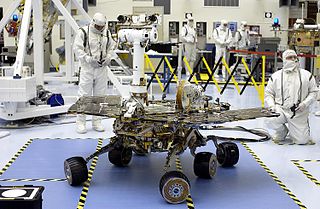
Spirit, also known as MER-A or MER-2, is a Mars robotic rover, active from 2004 to 2010. Spirit was operational on Mars for 2208 sols or 3.3 Martian years. It was one of two rovers of NASA's Mars Exploration Rover Mission managed by the Jet Propulsion Laboratory (JPL). Spirit landed successfully within the impact crater Gusev on Mars at 04:35 Ground UTC on January 4, 2004, three weeks before its twin, Opportunity (MER-B), which landed on the other side of the planet. Its name was chosen through a NASA-sponsored student essay competition. The rover got stuck in a "sand trap" in late 2009 at an angle that hampered recharging of its batteries; its last communication with Earth was on March 22, 2010.

Opportunity, also known as MER-B or MER-1, and nicknamed Oppy, is a robotic rover that was active on Mars from 2004 until mid-2018. Opportunity was operational on Mars for 5110 sols. Launched on July 7, 2003, as part of NASA's Mars Exploration Rover program, it landed in Meridiani Planum on January 25, 2004, three weeks after its twin Spirit (MER-A) touched down on the other side of the planet. With a planned 90-sol duration of activity, Spirit functioned until it got stuck in 2009 and ceased communications in 2010, while Opportunity was able to stay operational for 5111 sols after landing, maintaining its power and key systems through continual recharging of its batteries using solar power, and hibernating during events such as dust storms to save power. This careful operation allowed Opportunity to operate for 57 times its designed lifespan, exceeding the initial plan by 14 years, 46 days. By June 10, 2018, when it last contacted NASA, the rover had traveled a distance of 45.16 kilometers.

A Mars rover is a motor vehicle designed to travel on the surface of Mars. Rovers have several advantages over stationary landers: they examine more territory, they can be directed to interesting features, they can place themselves in sunny positions to weather winter months, and they can advance the knowledge of how to perform very remote robotic vehicle control. They serve a different purpose than orbital spacecraft like Mars Reconnaissance Orbiter. A more recent development is the Mars helicopter.

Suspension is the system of tires, tire air, springs, shock absorbers and linkages that connects a vehicle to its wheels and allows relative motion between the two. Suspension systems must support both road holding/handling and ride quality, which are at odds with each other. The tuning of suspensions involves finding the right compromise. It is important for the suspension to keep the road wheel in contact with the road surface as much as possible, because all the road or ground forces acting on the vehicle do so through the contact patches of the tires. The suspension also protects the vehicle itself and any cargo or luggage from damage and wear. The design of front and rear suspension of a car may be different.

Mars Science Laboratory (MSL) is a robotic space probe mission to Mars launched by NASA on November 26, 2011, which successfully landed Curiosity, a Mars rover, in Gale Crater on August 6, 2012. The overall objectives include investigating Mars' habitability, studying its climate and geology, and collecting data for a human mission to Mars. The rover carries a variety of scientific instruments designed by an international team.

In both road and rail vehicles, the wheelbase is the horizontal distance between the centers of the front and rear wheels. For road vehicles with more than two axles, the wheelbase is the distance between the steering (front) axle and the centerpoint of the driving axle group. In the case of a tri-axle truck, the wheelbase would be the distance between the steering axle and a point midway between the two rear axles.

An anti-roll bar is a part of many automobile suspensions that helps reduce the body roll of a vehicle during fast cornering or over road irregularities. It connects opposite (left/right) wheels together through short lever arms linked by a torsion spring. A sway bar increases the suspension's roll stiffness—its resistance to roll in turns—independent of its spring rate in the vertical direction. The first stabilizer bar patent was awarded to Canadian inventor Stephen Coleman of Fredericton, New Brunswick on April 22, 1919.

ATHLETE is a six-legged robotic lunar rover under development by the Jet Propulsion Laboratory (JPL). ATHLETE is a testbed for systems, and is designed for use on the Moon.
The embedded computer systems on board the Mars rovers sent by NASA must withstand the high radiation levels and large temperature changes in space. For this reason their computational resources are limited compared to systems commonly used on Earth.
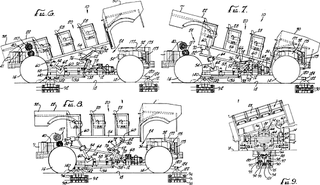
An enhanced motion vehicle, or EMV, is a ride vehicle developed by Walt Disney Imagineering, a component of The Walt Disney Company, for use in amusement park rides located at Disney's theme parks. Riders are seated on a modified motion simulator base that is mounted on a wheeled chassis. As the vehicle travels through the attraction, the motion base simulates movement, such as driving over rough terrain or leaning through a turn, that makes the ride experience appear more realistic.

Curiosity is a car-sized Mars rover designed to explore the Gale crater on Mars as part of NASA's Mars Science Laboratory (MSL) mission. Curiosity was launched from Cape Canaveral (CCAFS) on 26 November 2011, at 15:02:00 UTC and landed on Aeolis Palus inside Gale crater on Mars on 6 August 2012, 05:17:57 UTC. The Bradbury Landing site was less than 2.4 km (1.5 mi) from the center of the rover's touchdown target after a 560 million km (350 million mi) journey.
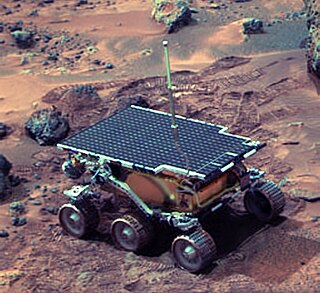
Sojourner is a robotic Mars rover that landed in the Ares Vallis channel in the Chryse Planitia region of the Oxia Palus quadrangle on July 4, 1997. Sojourner was operational on Mars for 92 sols. It was the first wheeled vehicle to rove on a planet other than Earth and formed part of the Mars Pathfinder mission.

Mars 2020 is a Mars rover mission forming part of NASA's Mars Exploration Program that includes the rover Perseverance and the small robotic, coaxial helicopter Ingenuity. Mars 2020 was launched from Earth on an Atlas V launch vehicle at 11:50:01 UTC on 30 July 2020, and confirmation of touch down in the Martian crater Jezero was received at 20:55 UTC on 18 February 2021. On 5 March 2021, NASA named the landing site of the rover Octavia E. Butler Landing. As of 14 June 2022, Perseverance and Ingenuity have been on Mars for 468 sols.

Crewed Mars rovers are Mars rovers for transporting people on the planet Mars, and have been conceptualized as part of human missions to that planet.
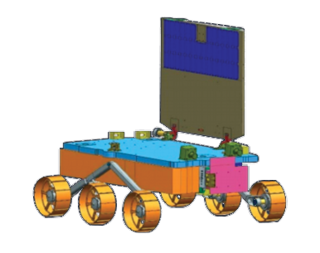
Pragyan was the rover of Chandrayaan-2, a lunar mission developed by the Indian Space Research Organisation (ISRO), that launched in July 2019. Pragyan was destroyed along with its lander, Vikram, when it crash-landed on the Moon in September 2019 and never got the chance to deploy.

Perseverance, nicknamed Percy, is a car-sized Mars rover designed to explore the Jezero crater on Mars as part of NASA's Mars 2020 mission. It was manufactured by the Jet Propulsion Laboratory and launched on 30 July 2020, at 11:50 UTC. Confirmation that the rover successfully landed on Mars was received on 18 February 2021, at 20:55 UTC. As of 14 June 2022, Perseverance has been active on Mars for 468 sols since its landing. Following the rover's arrival, NASA named the landing site Octavia E. Butler Landing.

PrOP-M were two Soviet Mars rovers that were launched on the unsuccessful Mars 2 and Mars 3 missions in 1971. PrOP-M were the first rovers to be launched to Mars, 26 years before the first successful rover mission of NASA's Sojourner in 1997. Because the Mars 2 and Mars 3 missions failed, the existence of the rovers was kept secret for nearly 20 years.






















